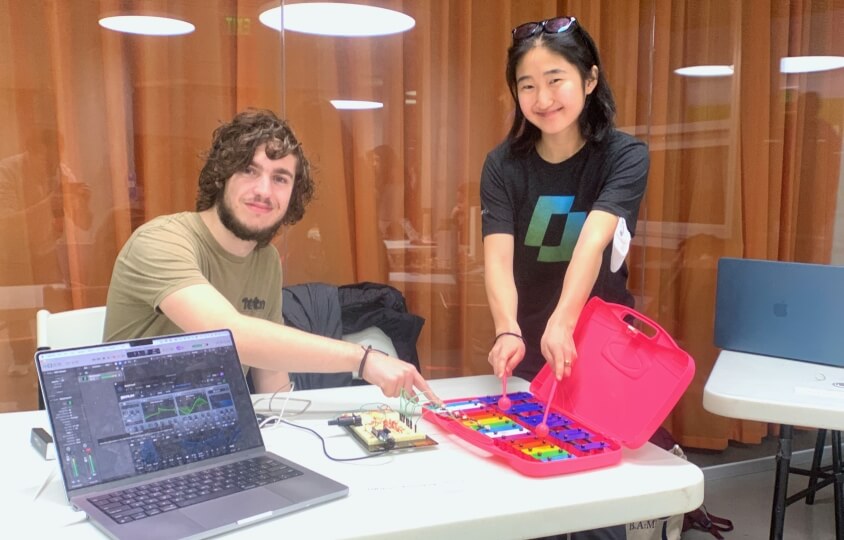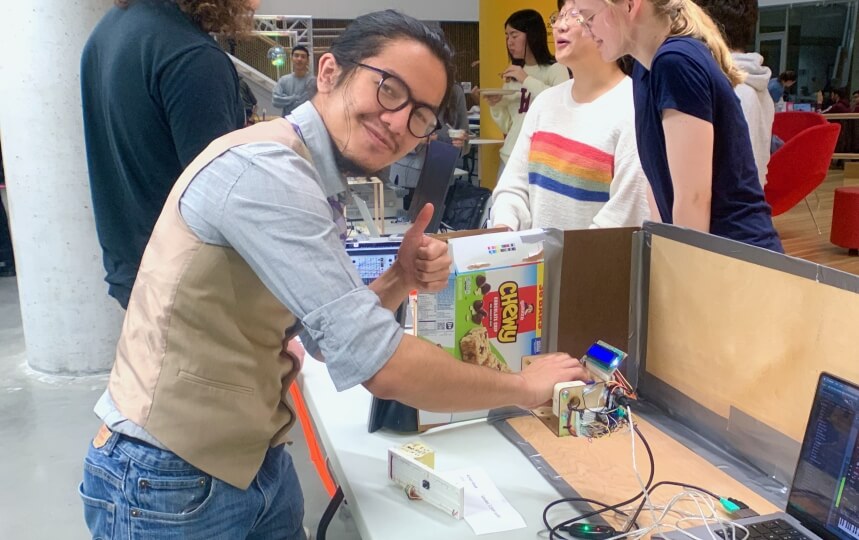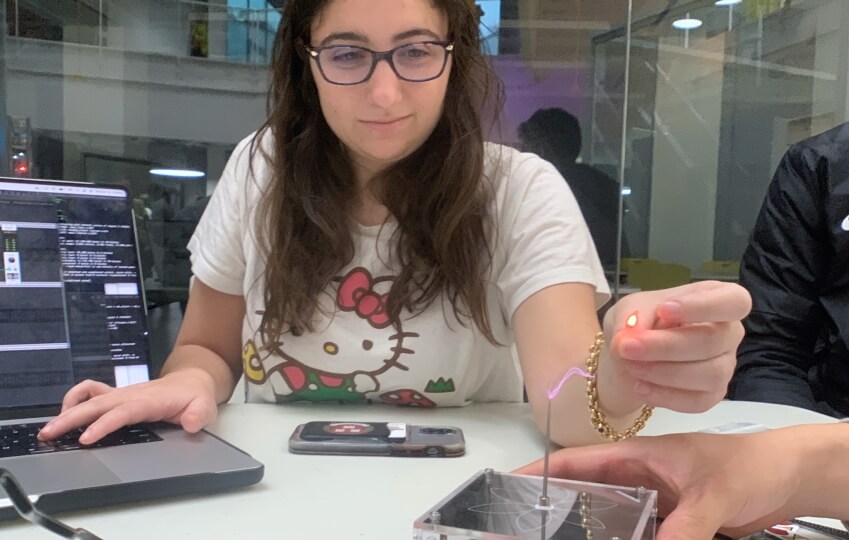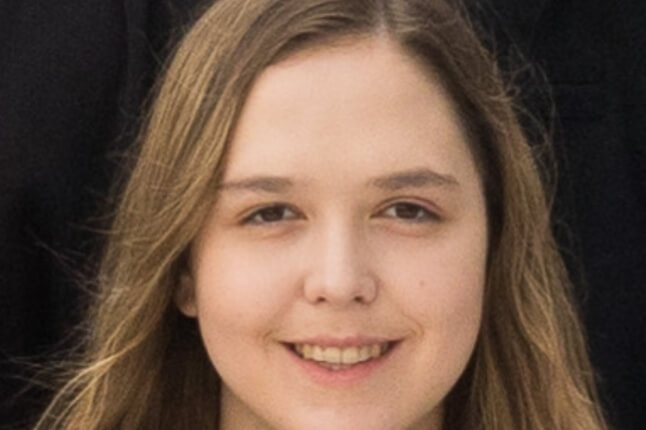News
Cliff Stowe and Karina Chung with their Glockensynth, which combines an electronic synthesizer and glockenspiel (Matt Goisman/SEAS)
The lowest level of the Science and Engineering Complex’s main atrium looked like part orchestral pit, part rock and roll band stand, and part electronic workshop. Synthesized beats and notes meshed with stringed instruments strumming out both classical and pop tunes. The air sizzled with the figurative power of student ingenuity and the literal power of a small tesla coil producing sound by charging the air.
The annual December festival for “GENED1080: How Music Works: Engineering the Acoustical World” highlighted the creativity of Harvard students pursuing a range of concentrations at Harvard John A. Paulson School of Engineering and Applied Sciences (SEAS) and Faculty of Arts and Sciences.
“When you see it all come together, when you see all these student projects and their creativity, it’s extremely gratifying,” said professor Robert J. Wood, Harry Lewis and Marlyn McGrath Professor of Engineering and Applied Sciences at SEAS. “They’ll explore new topics or bring in their own interests. Several of the students are combining this and another class project, so making these connections across a wide range of student interests is a huge part of the process.”
People relate to music in all kinds of ways, and classes like GENED1080 bring in a wide range of students. Wood gives them free reign to design their own instruments and electronic devices for their final projects, so long as they meet a few basic parameters.
“This isn’t about being lazy and not defining the project – this is about not burdening the students with too many constraints for their projects, and letting their creativity flow,” Wood said. “That pays off tremendously year after year – the students outdo themselves.”
Aiman Anuar with his handheld theremin (Matt Goisman/SEAS)
Aiman Anuar, a second-year mechanical engineering student, connected his GENED1080 coursework to the introductory robotics course he also took in the fall. That course taught him how to manipulate robotic arms in three dimensions using a coordinate system. For the festival, he built a handheld theremin, called the “Music in XYZ Cartesian Coordinate System,” that changes the notes and volume played depending on where the device is positioned.
“A normal theremin works by using radio frequencies, where notes play when your hand changes the capacitance of an antenna to sense distance,” Anuar said. “I’ve used ultrasonic sensors to determine the theremin’s position in real time. Robotics is very spatially oriented, and the idea of spatial movement inspired this. As you move it around, it changes the music.”
First-year students Sava Thurber and Elizabeth Norris are both members of the Harvard Radcliffe Orchestra, and their experiences as performing musicians inspired their final project, called “Strings.amplify().” They attached piezoelectric discs to their instruments (cello and violin), which generate a voltage proportional to the vibrations they detect as the instruments are played. This voltage is boosted by a preamplifier circuit they built, which can then be played through a traditional electronic amplifier. The end result was an inexpensive way to retrofit acoustic instruments for electric amplification with a low risk of physically damaging the instrument.
“I took this class because I’m really interested in learning more about electroacoustics,” Norris said. “I’m pretty comfortable with classical instruments, but I haven’t worked much with electronic effects. This was a cool way to learn more about circuitry and electrical engineering.”
Thurber added, “I really loved the final project because it was so open-ended. Walking around here, it’s really cool seeing people’s projects.”
Sava Thurber and Elizabeth Norris demonstrate their amplifier hookups for acoustic instruments. (Matt Goisman/SEAS)
Finn Glew plays his lap steel guitar (Matt Goisman/SEAS)
Finn Glew, a third-year psychology and neuroscience student, took GENED1080 because “I love making things, and this course is all about making things.” One of the most valuable lessons he learned was how to set achievable parameters for engineering projects. After several attempts fell short of expectations, he and partner Emil Massad went with a simpler final project, building two lap steel guitars from scratch.
“Time and time again, music shows us that beauty blooms from simplicity,” Glew said. “This was made out of an old hardwood desk, and it was stained and cut by hand. It uses about $100 worth of pickups, but all the other hardware is either 3D-printed or laser-cut.”
Tori Kauffman demonstrates her group's Singing Tesla Coil
On the less traditional end, Tori Kauffman, Nathan Evands and Howard Huang built a Singing Tesla Coil. By emitting electricity at various voltages, the coil is able to play different notes. The volume can also be adjusted by using an object to reduce the amount of air around the coil.
“It was really cool in how it incorporated a lot of different aspects that we discussed,” said Kauffman, a second-year student studying computer science and math. “We spent a lot of time talking about how people hear and how music travels, so how electricity can disturb air to create music was very interesting. We tried to use a lot of information from the electronics unit.”
Karina Chung, a second-year applied math student, has a background in classical music. For her final project, she and partner Cliff Stowe built the Glockensynth, which combines an electronic synthesizer with a glockenspiel, a metallic percussive instrument that sounds similar to a xylophone.
“We had no electrical or hardware background, so we really wanted to push ourselves on the electrical engineering end,” Chung said. “This class definitely broadened for me what I thought was possible with music, and what I could create. It really changed my relationship to what music and composition is. Classical music composition was something I always thought was unreachable. But in this class I found the freedom to explore all these ranges of possibility.”
Topics: Academics
Cutting-edge science delivered direct to your inbox.
Join the Harvard SEAS mailing list.
Press Contact
Matt Goisman | mgoisman@g.harvard.edu







